Without question, China’s best wines are made by those estates that over the years have invested not just in know-how, equipment and vineyards, but which have remained true to a Chinese viewpoint and sensitivity. To the country’s culture, even. And so it is that the country’s best wines are practically never those made with the ubiquitous Cabernet Sauvignon and Merlot, but rather those made with highly local varieties such as Marselan, Petit Manseng and Cabernet Gernischt (which should not be taken, knee-jerk reflex-like, to be Carmènere despite what you will read elsewhere. See TerroirSense Wine Review, Terroir Academy section, September 24, 2021: Cabernet Gernischt: A Chinese Grape Variety and Wine). But there are always exceptions, and it is genuinely startingly to me how good some Chinese Pinot Noir and Chardonnay wines are: no, Burgundy need not quiver in its boots just yet (and for that matter, Oregon, New Zealand and Ontario’s Niagara are safe too) but it is safe to say that these are two international grape varieties the Chinese should continue to look into. Clearly, just how you “look into” something makes all the difference in the world; and in this respect the Canaan winery and Domaine Franco-Chinois (two wineries, but one owner) are a marvellously shining example of what is so good and right in Chinese wine today.
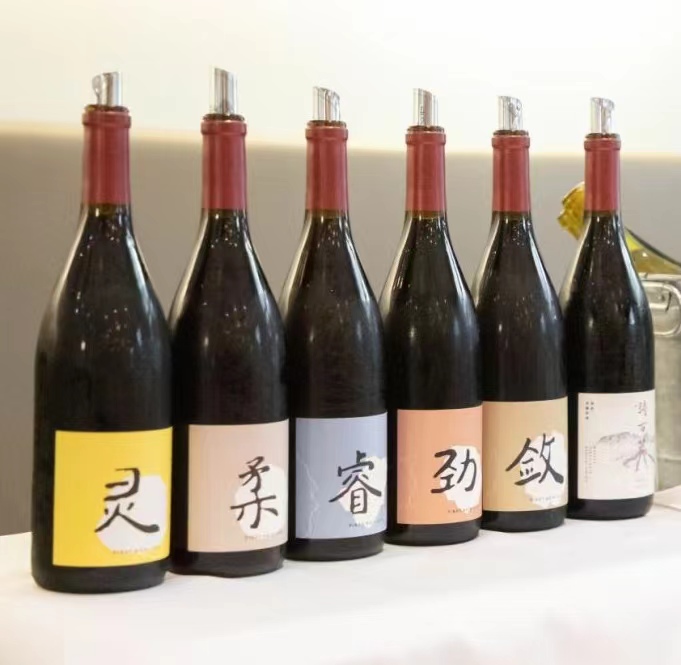
The two are high-quality estates located side by side in Huailai (Hebei Province) in central Northern China, a little under a two-hour drive from Beijing, China’s capital city (or a little more than thirty minutes by fast train). The Domaine Franco Chinois (DFC) is a boutique winery founded in 1999 with the support of former Chinese Prime Minister Wen Jiabao and French President Jacques Chirac. The winery’s name derives from the fact it was originally a joint venture between the countries of France and China. It was the setting for the planting of sixteen varieties (and twenty-one clones); those that remain in the vineyards today are those that adapted best to, and give the best wine results in, Huailai’s terroir.
The Domaine Franco-Chinois was bought in 2010 by Cher Wang (according to Forbes, the 54th most powerful woman in the world), the founder of HTC technology and daughter of Wang Yung Ching, one of Taiwan’s wealthiest men. At the time of the acquisition, Cher Wang already owned Canaan Winery, that was founded in 2006, or just a little later than the Domaine Franco-Chinois. Though not in the wine business originally, she and the family were/are wine-lovers, and she dreamed of making the finest wine possible in China; through the help of friends, she commissioned a group of people [mostly American and Australians from UC Davis and Purdue University mainly; it was Purdue University oenology professor Dr. Christian Butzke who was tasked to assemble and lead an international team of experts including Richard Smart (perhaps also the world’s single biggest authority on vineyard canopy management) from Australia and Paul Skinner from California] to come to China in search of the most suitable land in which to plant vines. To help you understand the scope and seriousness of the Canaan project, just imagine that all these people travelled three years in China, covered by foot most of the North China provinces (and keep in mind that China is the world’s third biggest country, so it’s not like theirs was exactly a Sunday walk in the park), finally deciding that Huailai, in Hebei Province, was the best spot in which to set up the new winery called Canaan.
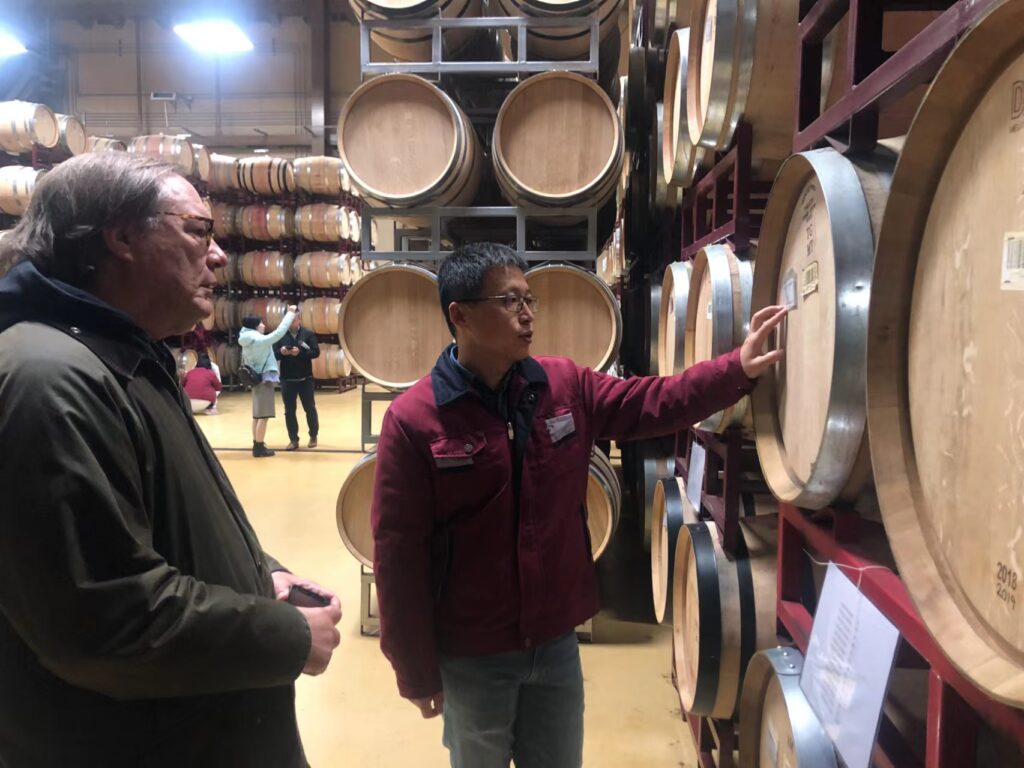
The two estates are brilliantly managed by Richard Li, one of the most knowledgeable and competent wine business people in China who joined in 2019 as CEO of the winery group, who oversees a first-rate team. The quality of wine undoubtedly begins in the vineyards, but it helps when you have bright, knowledgeable and hard-working people running the show. And then some. This is the case at Domaine Franco-Chinois and Canaan Winery.
Research and Development at Canaan and Franco-Chinois
What sets these two wineries apart from most others in China (and not just China, in fact) is their investment in research and development, the fruits of which are starting to be more than just tasty. For example, the Petit Manseng late harvest wine by Domaine Franco-Chinois is not just one of China’s two best wines (LVMH/Cheval Blanc’s Ao Yun red grand vin is the other) but a really world-class wine in its own right. Furthermore, numerous other wines made by these two wineries rank amongst the country’s best wines and are of comparable quality to many famous international wines. The capacity to come up with wines that are the consequence of experimenting as well as thinking and seeing things through is demonstrated admirably well by their latest releases that I describe in this report, two series of small-batch wines from Canaan devoted to individual Pinot Noir clones and to orange wines.
Originally, it was at Domaine Franco-Chinois that a laboratory was set up in 1998, run by Desheng Zhao (by the way, not that it matters much in this context, I’m sure, but allow me to say, a great guy) a graduate of a winemaking program in China and appointed by the Ministries of Agriculture of the two countries to go study in France so as to be better prepared for the task at hand. He returned to China in 2001 and now runs the labs of both Franco-Chinois and Canaan, assisted by Brandy Wu and Helen Wu. He also works closely with Maria Zhang who is in charge of viticulture as the Vineyard Manager where she established the nursery and oversees a professional viticulture team of 150 people, aided by her key assistants Hui Jun and Fang Kai. Since 2011, the team at Canaan/Franco-Chinois has been involved in numerous experiments relative to growing different varieties ranging from Welshriesling (Italian Riesling) to Durif to Marquette; different pruning techniques; burying of the vines technology and techniques; natural and orange winemaking; and a whole lot more. It really is a first-rate, impressive operation.
The history and types of Pinot Noir clones and Canaan Winery/Domaine Franco-Chinois
The Pinot Noir clones grown at Canaan are seven (all obtained from California), five of which were used to produce the series of individual Pinot Noir clone bottlings presented in this report; but others, such as the Pommard 5, were included in the official Canaan Winery Pinot Noir bottling that is made regularly and goes on sale every year and is part of the estate’s series of wines called Chapter and Verse. The were planted from 2012 to 2015 on mostly on 101-14 and SO4 rootstocks in soils that are roughly 38% loam, 22.6% silty-loam,16.6% clay-loam, 15.3% sandy-loam at 920-1050 meters above sea level. The clones to be planted were chosen based on low vigour and relatively compact bunches aiming to avoid short growth cycles given the overall cool climate of the area such that early budding varieties and clones are at a risk of unexpected or late spring frosts.
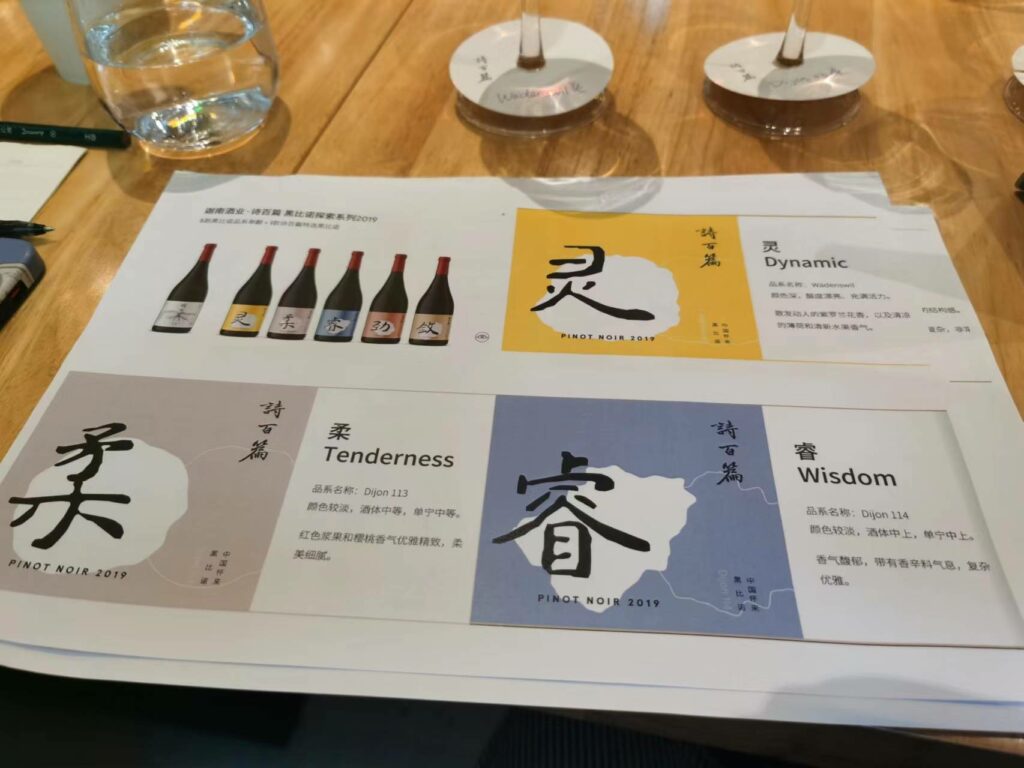
Here is the description of the five Pinot Noir clones the wines of which are included in the box set and that I describe in this report (see tasting notes and scores below). Interestingly, the winery opted to limit the box set to five individual clone wines only, plus the official estate Pinot Noir bottling, but they did not choose the five they included in the box set because they felt them to be superior to the other two clones. In fact, the Pinot Noir clone Pommard 5, the wine of which is not included in the box set, is instead a big part of the blend of the estate’s Pinot Noir bottling released for commercial sale, so you know it just has to be quite good indeed; I am told that the Pinot Noir clones selected for the individual bottlings of the box set will vary from year to year, but that, understandably enough, it was decided for marketing and practical reasons not to bottle all the individual clones. No doubt, it is much easier to package and send a six-bottle set than one made up of seven or eight bottles.
Note that the descriptions that follow (except where I state differently and or make distinguos) are about what these clones look like and how they behave in China; therefore, these are not generic descriptions that have been copied from New Zealand, California Niagara or French experiences and that you can find everywhere on the internet, but are rather specific to the clones in China (or Huailai, for precision’s sake).
Pinot Noir clone Wadenswil: Medium conical wing, larger bunches than Pinot Noir clones 113 and 114; small medium-sized grapes; but more resistant than those two clones. There is the need to control yields closely with this clone. Historically, the Wadenswil clone was a selection performed in the 1950s at the Swiss Federal Research Station located in the town of Wädenswil, Switzerland (hence the spelling of the clone as Wädenswil, with the umlaut over the ‘a’, in the Germanic parts of the world). Legend has it the original Pinot Noir grapevines from which the clonal selection was made were brought to the Zurich area by Swiss mercenaries who fought for the King of France during the Burgundian Wars of the 1470s. The accuracy of that lore notwithstanding, the Wädenswil clone was selected for its ability to ripen well in cool climates as well as its natural disease resistance, qualities that contributed to its success in cool-climate areas such as Oregon and China’s Huailai region too. In parts of Oregon, this clone has been linked to savoury, even rustic wines that remind of spiced meat and forest floor, but in China it seems to give outstanding wines of delicate red fruit and floral nuances of real class.
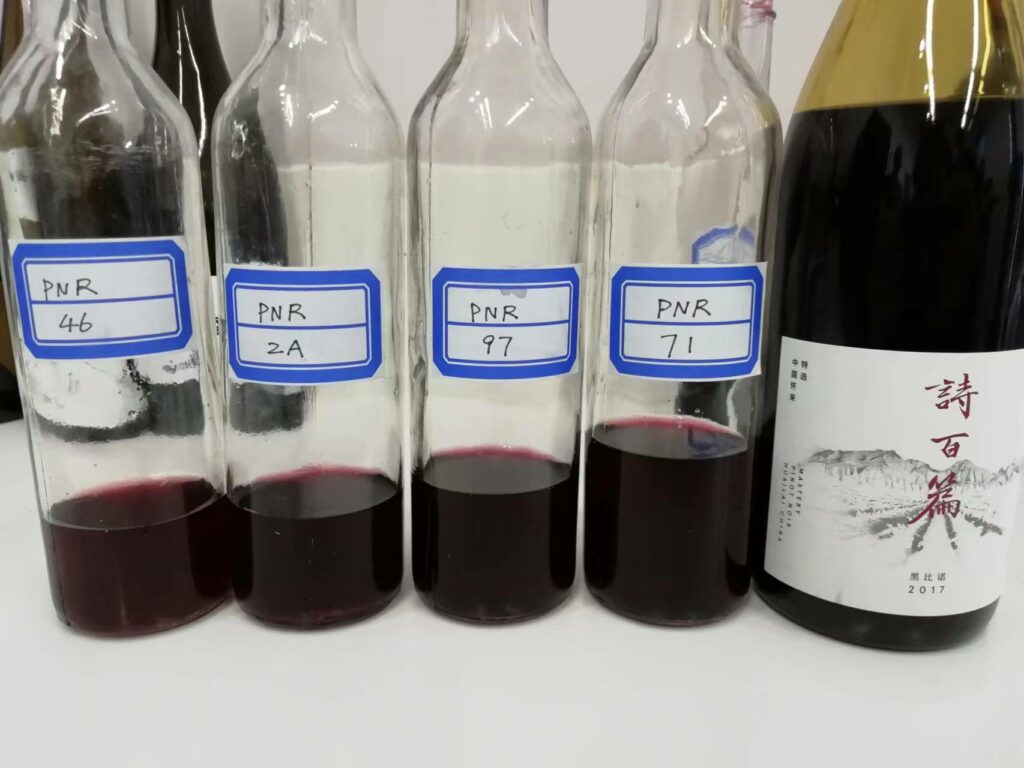
Pinot Noir clone113: Small to medium-sized bunches; small to medium-sized berries; susceptible to grey acid rot; while elsewhere in the world it has been stated that this clone gives uneven yields, not so in China where yields with this clone tend to be copious and so need to be watched carefully and controlled; wines of strong color and elegance. In sadder times when all everyone wrote about was the blackest, biggest wines possible (what a joke with Pinot Noir!), this Pinot Noir clone, as well as the Wadenswill and the 114, were all felt to give wines of only average or variable quality. In fact, here in China it seems to give outstanding wines. Clone 113 gives wines that are rather similar to those made with the Wadenswill clone and that are actually very different from those made with Pinot Noir clone 114. See clone 114 for the history behind these two Pinot Nir clones.
Pinot Noir clone 114: In China (or at least in Huailai) this Pinot Noir clone looks and behaves similarly to the Pinot Noir clone 113. Therefore, it has small to medium-sized bunches; small to medium-sized berries; susceptible to grey acid rot; by contrast, this clone’s wines are undoubtedly darker in colour than those of Pinot Noir clone 113 (and of the Wadenswil too) and are marked by darker fruit (black cherry) aromas and flavours too. Strikes me as there being better sugar accumulation and therefore the potential for higher degree of alcohol, but I may well be mistaken given the limited experience tasting the wines made from the clones (only two vintages so far). This clone is, like the 113 and 115, nicknamed “Dijon” and has become world-famous, originating in France but finding a real home in Oregon (where it got its nickname) and only then moving to California and the rest of the world. Back in the 1950s, Burgundian winemakers were besides themselves because of the triple whammy of late harvests (in a cold climate area, so you can imagine what fun that was for the poor farmers), viral-affected grapevines, and rot-related problems. It was thanks to a researcher named Raymond Bernard that big help was on the way: he started working on clonal selection and was helped in this by famous local vigneron Jean-Marie Ponsot, who provided grapevines from his Clos de la Roche for early trials. It was these cuttings that are the original source for clones 113, 114 and 115 that were first sent to Oregon thanks to David Adelsheim (of Oregon’s well-known Adelsheim Vineyard winery) and Dr. David Heatherbell (Professor of Enology at Oregon State University) who convinced Bernard to share not just his Pinot Noir clones but some of Chardonnay clones too. These clones were nicknamed “Dijon clones” 113, 114, 115 (but there are others too, such as 667 and 777) by the laboratory technicians at Oregon State University calling them by the return city address on the transport boxes when the cuttings arrived in 1987 and 1988.
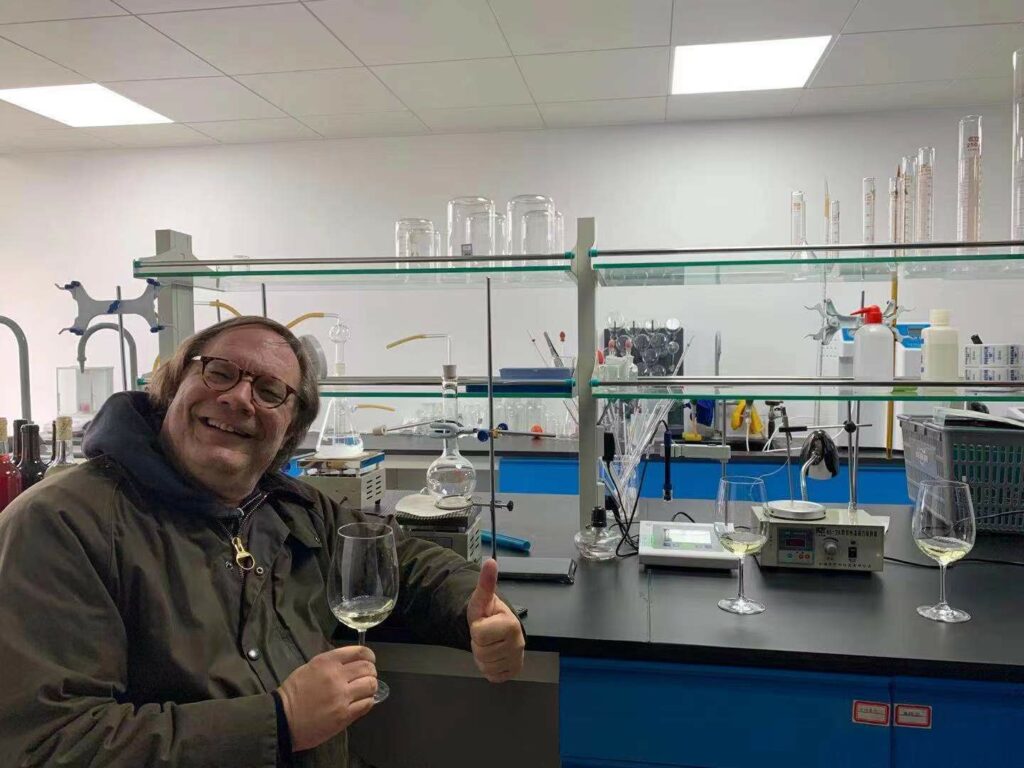
Pinot Noir clone 777: Medium-sized bunch (not small, as it is described outside of China), round-conical in shape and compact; small-sized berries; good annual productive capacity and yields that are less than those of clones 113 and 114; the wines are the darkest in colour compared to those of all the other clones; marked by almost jammy dark fruit aromas and flavours (“Port-like” smiles Richard Li, who also points out this is the Pinot Noir wine the clone of which he can always recognize when tasting blind); the wines do not strike me at all as being “aromatic” or “perfumed” as is often described in other countries, just rather big and massive, or Pinot Noirs for Cabernet- or Syrah- lovers, if you will.
Pinot Noir clone Swan or clone 97: small cylindrical-shaped, compact bunch; small to medium-sized berries; intermediate disease resistance; its annual production levels are the lowest of all the clones planted at Canaan; its wines are riper in style than those of all the others save for those of clone 777 but are also the less Pinot Noir-like wines of any of the clones planted at Canaan. Richard Li tells me this is often the wine he has trouble recognizing it as Pinot Noir, when tasting blind (I can’t say I blame him, given what I have tasted too). The Swan clone, also known as clone 97 (or UCD 97, from University of California-Davis), is a “heritage clone” much like are the Pinot Noir Wente, Pinot Noir Hanzell, Pinot Noir Mount Eden and Pinot Noir Calera clones, all of which stemmed from illegally smuggled field selections brought to the United Sates in suitcases, and hence also nicknamed “suitcase” clones. This was done because of quarantines and disease-related fears associated with bringing in plant material to a different country, something that outside of government agencies is not allowed. Only a country’s specific government agency, in charge of regulating and controlling the origin and health status of plants, including grapevines, can bring plant material into the country. While these clones can in theory give nuanced wines, they also appear to be very site-specific and do not replicate the traits one expects them to show in every place they are planted (which seems to also be the case in China; or at least, it appears to be so in Huailai). This may be in part due to different soils and water regimens, different farming techniques and harvest dates of the new lands the heritage clones are planted in but also because heritage clones present noteworthy plant material diversity given their undocumented field selection origin. Because of their uncertain origin (clearly those who smuggle vines into a country are never particularly inclined to talk much or admit anything about them), heritage clones are not often a uniform population. In other words, these clones are not always exactly what they were thought to be or are told they are (for example, the person doing the smuggling might have thought he was bringing back five or six or seven Pinot Noir vines but they may not have been so at all; and given the lack of documentation we have no way of knowing of what exactly was brought back). This would most certainly lead to different wines made independently of any differences of geology and water regimens. The Swan clone’s history is especially complex. Named after Joseph Swan Vineyards in Sonoma where the Pinot Noir vines had been sourced from, these Pinot Noir vines had been planted there had originally come from the Mount Eden winery, so they should really be known as Mount Eden clones. However, Mount Eden is already associated with one heritage clone, the clone UCD 37, and it does not appear that the Swan clone is one and the same. Rather, it is believed to be a mix of different vines all named “Swan clone” by Francis Mahoney, who in 1996 submitted cuttings from the Carneros Creek Clonal Trial to the US regulatory body on grapevine planting material, the Foundation Plant Material Services. Ultimately, the clone virus-treated and registered officially as UCD 97 or FPS 97, though the “Swan” monicker has also stuck.
The wines in general
The Canaan individual Pinot Noir clone wines are traditionally made, including fourteen days of skin contact, controlled temperature stainless-steel fermentation, and aging fourteen to sixteen months in small French oak barrels. The wines are bottled with attractive, very colorful labels each sporting a large Chinese pictogram and each bearing a specific nickname meant to recall a main personality trait of that wine. For example, and not surprisingly, the wine made with clone 777 (that usually gives big beefy wines, and it is no different here) is nicknamed “power”. The first wines from individual Pinot Noir clones were made with the 2016 vintage. Only recently though has the volume of bottles become sufficiently large enough (but production volumes remain very small: only 600 bottles of each Pinot Noir clone are made, for a total of 120 sets) such that these individual box sets are made available to an extremely limited number of specific wine educators and writers (hello there!), a few dedicated high quality wine bars/restaurants, and individual wine collectors in China. In the future, the wines may well be released commercially to the general public, but not presently. Eventually, time will tell, they may be made available to international citizens as well. In the meantime, you have me to tell you about them.
The wines in the tasting
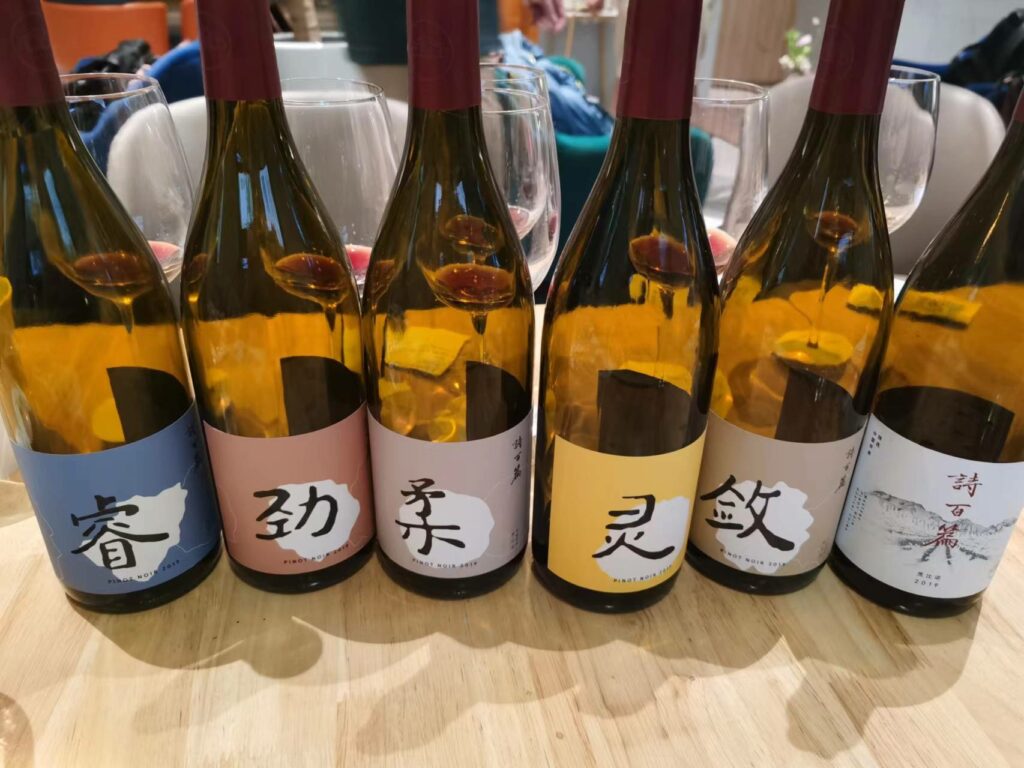
Canaan Winery 2019 Pinot Noir Clone Wadenswill ‘Dynamic’ Huailai Hebei 92
Bright pale red. Very pretty and lively on the nose, with delicately spicy nuances of mint and red cherry and berries that turn slight caramelly at the back. Then also lovely red fruit flavours that have noteworthy lemony bite, finishing long and vibrant with notes of herbs and tobacco, rose and licorice and a violet topnote. Nicknamed “dynamic” because of the lively, free-flowing nature it transmits, mostly because of its acidity; some of the local tasters I was with found this too acid for their liking but I think its acidity is harmonious and really helps lift and extend the aromas and flavours on the elegant finish. I also found this to be the most complex and nuanced of all the Canaan individual Pinot Noir wines. Drinking window: 2024-2028.
Canaan Winery 2019 Pinot Noir Clone Dijon 113 ‘Tenderness’ Huailai Hebei 90
Pale red hue; this is the palest of the Pinot Noir clone wines though of about the same depth as the Wadenswil. Light and lively on both the nose and in the mouth, but slightly simple and straightforward initially, hinting at aromas and flavours of strawberry, fresh citrus and violet. Then gains complexity and size with aeration, becoming fruitier but still without the nuance and multifaceted personality of the Wadenswill. Easy to drink, easy to like, easy to understand. Drinking window: 2024-2028.
Canaan Winery 2019 Pinot Noir Clone Dijon 114 ‘Wisdom’ Huailai Hebei 91
Dark red; this is noticeably darker than the Wadenswil and the Pinot Noir clone 113 wine. Bigger and spicier but also more monotonal than those two wines on the nose. Broad, almost massive in the mouth entering fruity and then turning richer and denser in the middle, but finishes somewhat linear and without much in the way of multifaceted complexity. Very clean and nicely focused and energetic on the long very pure finish. Not the last word in complexity, but this is a lovely Pinot Noir wine, one that I think will probably blend very well with the clone. I can also see whay many people would prefer this wine to that of the Wadenswil or the 113. Drinking window: 2024-2029.
Canaan Winery 2019 Pinot Noir Clone Dijon 777 ‘Power’ Huailai Hebei 89
Deep red-ruby. Aromas of dark berries, tar, licorice, and smoky plums are strongly dominated by raisins, figs stewed in Port and spices. Rich, broad and mouthcoating with little in the way of refinement but plenty of texture and power to its dark fruit and spice flavours. Clsoes long and ripe, but not especially nuanced. This is always the last clone to be harvested at canaan (there is as much as a two to three-week delay between the picking dates of clone 113 and clone 777). It’s certainly easy enough to understand why they chose to nickname this clone’s wine as “power”. Drinking window: 2024-2029.
Canaan Winery 2019 Pinot Noir Clone Swan ‘Restraint’ Huailai Hebei 88
Medium-deep ruby-red. Ripe aromas of red and blue fruit with hints of caramel and guava, complicated by tobacco and vanilla. Then delicately fruity and sweetly spicy in the mouth with a new World Pinot Noir round mouthfeel and sweetness to it, but though a very good, smooth wine of real appeal, it didn’t really remind me of Pinot Noir. Drinking window: 2022-2028.
Canaan Winery 2019 Pinot Noir Chapter and Verse Huailai Hebei Shi Bai Pian 93
Good saturated red-ruby. High-pitched aromas of black cherry, licorice, violet and mint, complicated by a strong peppery note. Impressively vibrant, featuring building sweetness of rich blackberry, raspberry, licorice, tobacco, and flint flavours nicely framed by lively but polished tannins. The long aftertaste features a minty, floral note that lingers nicely. The best, deepest, most complex of all these Canaan Pinot Noir wines, it loses some of the daintiness and delicacy of the Wadenswill and 113 wines but is the most balanced and most complex wine of them all, a sure-fire sign that the technical team got their blend right (which in 2019 was: clone 114 (25%), clone 777 (25%), clone 97 or Swan (25%) with clones Wadenswil, 113 and Pommard 5 making up the remaining 25% . Drinking window: 2023-2030.
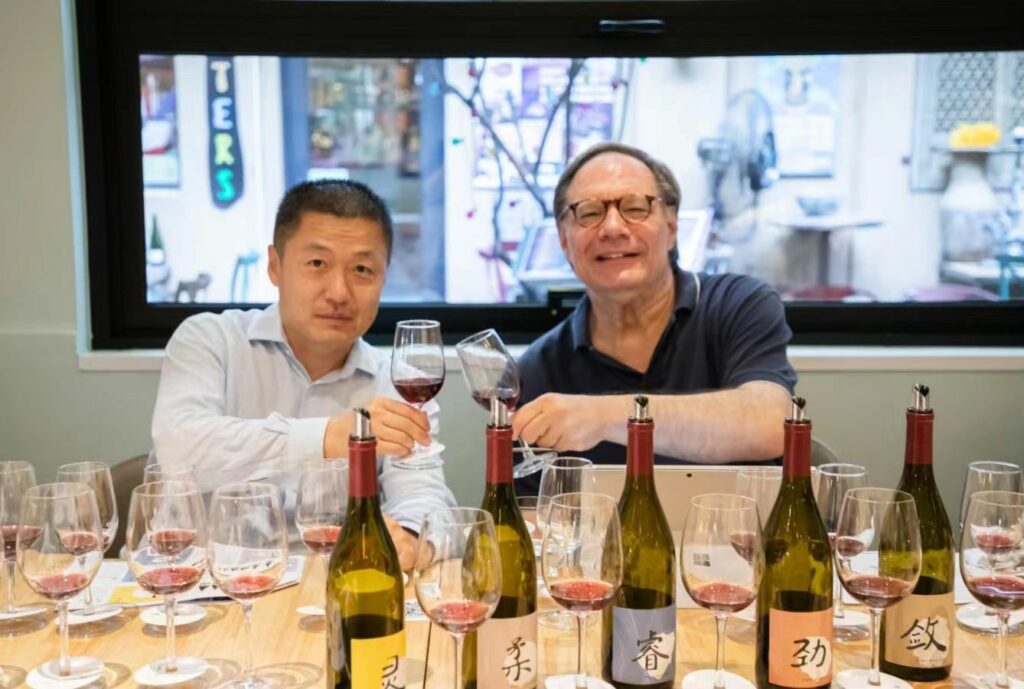

 中文
中文



